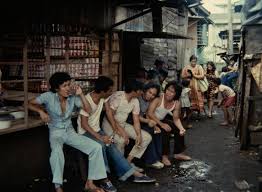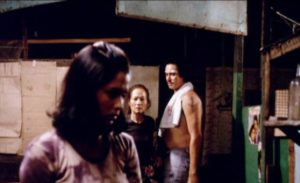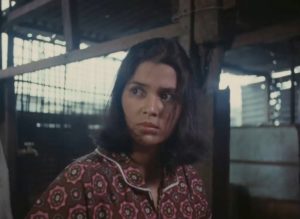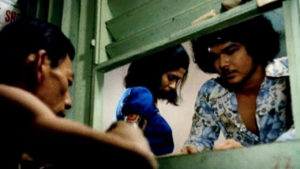Insiang, Lino Brocka’s celebrated 1976 melodrama of the Manila slums and the first Filipino film to ever screen at Cannes, opens with several ghastly, uninterrupted minutes inside a slaughterhouse.
It’s dirty, bloody, and brutal – pigs, hung upside down, bleed out from hastily punctured throats, before being tossed into vats of boiling water. As in nearly the entirety of the film that follows, Conrado Baltazar’s camera remains static, trapped, either refusing to look away or unable to do so. The soundtrack is a cacophony of death cries.
Welcome to Brocka’s Manila.
It’s a horrifying introduction. (Even this critic, a fan of horror films, as well as a vegan who has seen more than his fair share of slaughterhouse footage, gasped.) But, in its grisliness and near-vérité approach, it sets the stage for the series of interrelated stories to come. It also signals Brocka’s sensibility throughout Insiang: this is a world of casual cruelty, limited options, and cycles of violence that circumscribe the community like the actual garbage dumps that burn constantly along the perimeter of the slum. It’s a claustrophobic world of crushing poverty, where people do what they feel they have to, pitilessly, to survive.
The slum is called Tondo, and the guy introduced doing the stabbing on the line is Dado (Ruel Vernal). We will learn that he is a bully, a petty criminal, and a rapist to boot – in his first scene, he is simply a laborer engaged in the desensitizing drudgery of a particularly awful line of work. Later developments, however, will pointedly remind us of this moment we met him.
Dado has taken the much older Tonya as a lover (the strikingly-named and very accomplished actress Mona Lisa, a star of the 1930s Filipino screen, whose familiarity must have proved as jarring to Filipino audiences of the time as Jimmy Stewart’s turns for Hitchcock shook Western audiences, subverting expectation and image).
Tonya is also a nasty piece of work: still seething with rage at her abandonment by her ex-husband, she harangues anyone close at hand, emitting venom like some sort of wounded snake. Most of her nastiness falls on her daughter Insiang (the luminous Hilda Koronel, seemingly the only glimmer of beauty in Tondo).
Insiang is blameless and long-suffering, more or less holding the tiny house (initially crowded with extended family) together, but Tonya seems to view her as little more than the living reminder of how badly she herself has been betrayed by fate and a dissolute man. The notion of thanking Insiang for her work in and out of the house never for a moment occurs to Tonya: as far as the mother is concerned, her daughter owes her everything and more. A lifetime of service and abuse wouldn’t come close to fulfilling Tonya’s expectations of repayment.
Insiang dutifully accepts her lot in life, washing and delivering laundry, visiting the market, shouldering the insults and demands hurled her way. Tonya, in a decidedly Tonya-like move, throws the extended family out of the house – her reasoning is that, as they are the absent husband’s family and not contributing, they don’t deserve her charity. Her actual motive is much more carnal: to make room for her lover. Unfortunately, like seemingly everyone in town, Dado has designs on Insiang. Untrustworthy, duplicitous, and violent, he is not the roommate anyone would choose. Insiang rebukes his advances, while also obeying orders to leave the tap running at night, so the basin filling with water can obscure the sounds of her mother’s sex issuing from mere feet away. We are primed for a classic maternal melodrama.
Brocka and screenplay co-writer Mario O’Hara (on whose teleplay the film is based) give us that and more. Insiang is indeed a melodrama – it shares more than a little with Fassbinder’s contemporaneous productions, half a world away and similarly indebted to classic Hollywood – but takes a sharp turn in its final third. Its title character begins as innocent naïf, but the crushing demands of the world, and the relentless brutality of twin oppressions – poverty and patriarchy – create something of a monster.
Victimized by Dado, abused and mistreated by Tonya, used and discarded by her young “fiance” Bebot, Insiang crafts a revenge plot that ensnares and punishes everyone involved. Quietly but resolutely rejecting her status as cypher and tool, she grasps her own agency and becomes fully real by rerouting a world of violence back on those who thought her meek. Beware, as Fassbinder said, the holy whore.
No one, Brocka seemed to angrily declare with Insiang, gets out of this world clean.
The movie made a splash with French cinephiles on its Cannes showing, but struggled to catch on in the U.S., where Brocka has remained a minor figure. In an astute 2006 analysis of Insiang in Film Comment, José B. Capino wonders why. He attributes it to:
a curious disdain among American critics for [Brocka’s] melodramatic predilections … and the faulty (and contradictory) premise that his work aspires toward either neorealism or cinéma vérité.
The same could be said of Fassbinder. It’s an odd and ironic turn of events: adherents of Hollywood melodrama transposed its assumptions and precepts to local concerns, and somehow made the tradition unrecognizable in its country of cinematic origin, where audiences had long ago dismissed it as passé in favor of realist models imported from Europe and a strange, colonialist preference for exoticism and poverty porn.
Neither of which applies to Brocka here. Insiang is a morally complex, visually rich tragedy. Its crowded universe, where no one can so much as take a piss in private, provides ample opportunity for collision in the static visual field, but, as Noel Vera rightly observes, its classic three-act structure is almost austere (maybe resulting from its origin as a teleplay). There’s a sense of inevitability that runs throughout. The opening scene of slaughter maps perfectly onto a final one, and Insiang’s obvious pleasure in the culmination of her ploy – skillfully orchestrated by Brocka, who keeps you guessing at motivations – obscures any notion of innocence. Make no mistake: this is a fallen world. It’s everyone’s fault, and no one’s.
The Marcos Administration’s censors demanded the original ending – in which Insiang vocally rejects her mother – be changed, reasoning it immoral for a daughter ever to do so. Brocka complied, but got the last laugh. Not for the first time, statist censors succeeded only in ironically highlighting the degree to which they do not understand art.
Instead of a denunciation delivered with a fist in the air, as Brocka and O’Hara intended, Insiang closes with our protagonist silently wiping away tears, steeling herself as they dry, and then vanishing, ghost-like, back into the world that created her. The steady, motionless camera observes her as she fades.
It’s a truly haunting image, delivering the exact message the censors should’ve feared more, if they weren’t literalists.
That she’s still out there. That, as long as social conditions like grinding poverty and patriarchy are the rule of the day, her vengeance – just, unjust, outside of considerations of justice: you choose – is waiting, accumulating, like running water filling a basin or the garbage that lines the outskirts of town, waiting for a match to set it aflame.
(Insiang screened as part of the New Filipino Film Festival 2016 at the Yerba Buena Center for the Arts in San Francisco this past weekend. The program continues through July 3.)






